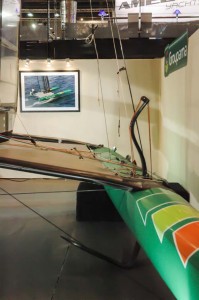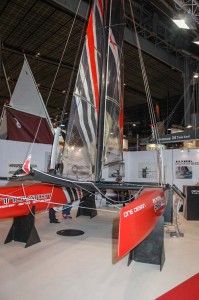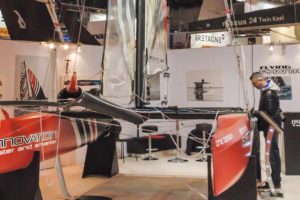By now most of you have already heard about the biggest announcement/news coming out of the Paris Boat show: namely that France has put together a team to challenge for the next America’s Cup in San Francisco. While France has historically participated in quite a few AC events, their track record has not been the greatest, which is surprising given how sailing mad the country is: the Mini Transat (a shout out to Seattle’s own Craig Horsfield for a top 10 finish in this year’s event on Naked Retreats http://www.craighorsfieldracing.com/ ) The Jules Verne, the Vendee Globe, The Figaro, the Tour de Voile – and their incredible training program for junior sailors (more on that later), would make it seem like France would be a great fit for the AC and yet they never seem to have put it together.
I think this time is different. Frank Cammas is the driving force behind this. The foiling, wing driven GroupAma Catamaran he recently won the “Little America’s Cup” with is here at the Paris Boat Show. And while its roped off to make it a bit hard to see the details of the engineering, the consensus of those that raced against them was that Cammas/GroupAma had the most sophisticated wing and best developed boat at the event.
Mix in the Bich family with its history of AC participation, GroupAma’s incredible success with major projects in the Multihull world well before the Little America’s Cup win and season with support from Canal TV – which has enough viewers that care about sailing that it can sustain a “Nautical Channel” in its regular cable offering and you have a team that is going to be a serious challenge.
Phantom 18
The Groupama C Class boat isn’t the only foiling catamaran here at the show. The new Phantom 18 is here as well. While not as aggressive as the GroupAma boat, sporting normal mylar sails in place of a wing, the Phantom still has “J-foils” that allow the boat to fully fly downwind and fly partially upwind.
 For those who haven’t quite figured out how these “J Foils” work They use the same principle of Dihedral that small planes like a Cessna use. By angling the two “wings” (parts of the J foil) upwards from the middle, everytime the boat heels to one side that foil gets pushed more level while the other side pushes up more vertical. The side that is more level then is generating lift vertically against the heel while the side that is more vertical reduces the amount of vertical lift it is generating and thus reduces its resistance to gravity. So the side that lifts more pushes back against the heel and the boat goes back to stable flight. Add in a horizontal tail fin and you basically have the same configuration a small airplane uses.
For those who haven’t quite figured out how these “J Foils” work They use the same principle of Dihedral that small planes like a Cessna use. By angling the two “wings” (parts of the J foil) upwards from the middle, everytime the boat heels to one side that foil gets pushed more level while the other side pushes up more vertical. The side that is more level then is generating lift vertically against the heel while the side that is more vertical reduces the amount of vertical lift it is generating and thus reduces its resistance to gravity. So the side that lifts more pushes back against the heel and the boat goes back to stable flight. Add in a horizontal tail fin and you basically have the same configuration a small airplane uses.
The Phantom 18 adds some cool features a horizontal jack-screw allows you to adjust the angle of attack of your foils as you are going – that lets you fly fully downwind, but reduces how much you fly upwind where having the hull skim the surface helps resist leeway.
Also the daggerboards are connected to the crew’s trapeze ring, so that when the crew “hooks up” they automatically raise the windward daggerboard to prevent it from catching on the tops of waves and spinning the boat out. 


